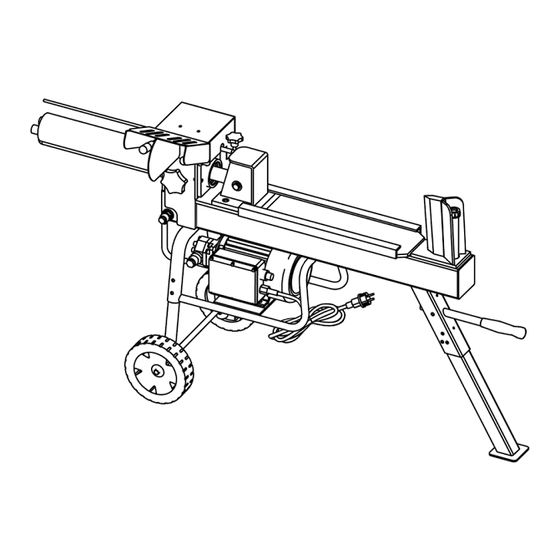
Table of Contents
Advertisement
Advertisement
Table of Contents

Summary of Contents for Parklander CW9T520
- Page 1 Model: CW9T520 Electric / Hydraulic Log Splitter OPERATOR’S MANUAL...
- Page 2 Please read the manual first. It will help you assemble, prepare, operate and maintain the unit for best performance. Pay special attention to the safety instructions before operating. For future reference, please copy the model number and the serial number of the equipment you purchased in the space below.
- Page 3 ּ◌ ּ◌ ּ◌ ּ◌ ּ◌ ּ◌ ּ◌ ּ◌ ּ◌ ּ◌ ּ◌ ּ◌ ּ◌ ּ◌ ּ◌ ּ◌ ּ◌ ּ◌ ּ◌ ּ◌ ּ◌ ּ◌ ּ◌ ּ◌ ּ◌ ּ◌ ּ◌ ּ◌ ּ◌ ּ◌ ּ◌ ּ◌ ּ◌ ּ◌ ּ◌ ּ◌ ּ◌ ּ◌ ּ◌ ּ◌ ּ◌ ּ◌ ּ◌ ּ◌ ּ◌ ּ◌ ּ◌ ּ◌ ּ◌ ּ◌ ּ◌ ּ◌ ּ◌ ּ◌ ּ◌ ּ◌ ּ◌ ּ◌ ּ◌ ּ◌ ּ◌ ּ◌ ּ◌ ּ◌ ּ◌ ּ◌ ּ◌ ּ◌ Electric circuit principle...
-
Page 4: Section 1: Know Your Log Splitter
3. Decals on machine Locate model plate and safety label on the equipment. Read and follow the instructions in them. Model plate (CW9T520) Note: S6 %40, continuous operation periodic duty: time of one load cycle is 10 minutes, operation time at constant load is 4 minutes, operation time at no-load is 6 minutes. - Page 5 Safety label Symbols meaning Read the manual carefully Warning: Fill hydraulic before assembly, operation and oil before using! maintenance. Wear safety gloves. Caution: Pinch point. Wear safety shoes or heavy Warning: Moving parts. Never boots. place body between log and ram during forward or reverse stroke.
-
Page 6: Technical Specifications
4. Technical specifications Technical specifications CW9T520 Electrical Voltage 230V±10% requirement Frequency 50±1 Hz <0.02 Power input 2900W Power output 2200W Rated current Motor speed 2800 rpm Thermal protector Protection degree IP44 Motor working mode S6 40% Power cable 3G1.5mm² Technical specifications... -
Page 7: Component Parts Diagram
5. Component parts diagram Note: Due to continuous product improvement, we reserve the right to change the product without prior notice. -
Page 8: Electric Circuit Principle Diagram
Ref. No. Part Description Ref. No. Part Description 1―2 Optional cross wedge 40―43 Motor rear end plate assembly Wedge Motor shell Dipstick Stator Tank Rotator Connecting box bottom assembly Nylon liner 48―53 Key switch assembly Motor frame 54―59 Capacitor assembly Rear leg 60―62 Cable fastener assembly... -
Page 9: Section 2: Safe Operating Instructions
SECTION 2: Safe Operating Instructions NOTE: This machine is only intended for homeowners to split firewood as detailed in instructions, not for any other purpose. Danger This machine was built to be operated according to the safety instructions in this manual. As with any type of power equipment, carelessness or error on the part of operator could endanger the personal safety and/or property of yourself and others. -
Page 10: Preparation Before Operating
NOTE: Dispose of the packing in an environmental friendly manner. Take to a proper collecting point. If you notice transport damage while unpacking, notify your supplier immediately. Don’t operate the machine. Read, understand and follow all safety instructions in this manual and labels on the equipment carefully. Keep the manual in a safe place for future and regular reference. -
Page 11: Maintenance And Repair
Allow only responsible adults who have read and understood the manual to operate this machine. Be familiar with all controls and proper operation. Know how to stop the machine quickly in the event of an emergency. Don’t operate the machine while under the influence of alcohol, drugs or medication. Only a single operator is allowed to load and operate this log splitter. - Page 12 The troubles of hydraulic system and motor other than described above should only be handled by qualified specialists. Periodically check the oil level in the hydraulic reservoir. If there’s a slow or erratic ram running during operation, it indicates the problem of oil shortage or excessive air in the reservoir. To solve this problem, please refer to the following Term 5.
Need help?
Do you have a question about the CW9T520 and is the answer not in the manual?
Questions and answers